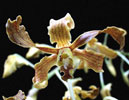|
|
|
|
|
| |
Flasks of
Dendrobium discolor 'MC1972' × self |
|
| |
|
|
| |
| Number: |
TN3549 |
| Name: |
Dendrobium discolor 'MC1972' × self
|
| Type: |
self (What's that?) |
|
Seed Donor: |
Dale Borders
|
|
Click to Enlarge

Pod Parent Flower |
|
|
|
| |
Culture Notes from Donor: Parent plant: Temperature range I (60-83°F)
For additional origin/habitat information supplied courtesy of
Charles and Margaret Baker, see further below, near the bottom of this page.
|
Temperatures we attempt to use in the lab & greenhouse:
| For Species: |
|
Spring, Summer, Autumn: days average 90°F, nights 74°F; best fit is Warm 90-70°F
(Source:
Baker's Web OSC) |
| For Species: |
|
Winter: days average 90°F, nights 74°F; best fit is Warm 90-70°F
(Source:
Baker's Web OSC) |
|
About the name...
| Etymology of |
Dendrobium |
|
From Greek "dendron" tree and "bios" life.
(Source:
Pridgeon 1992) |
| Etymology of |
discolor |
|
From Latin "discolor" of different colors, variegated.
(Source:
Brown 1956) |
| Pronunciation of |
Dendrobium |
|
den-DRO-bee-um
(Source:
Pridgeon 1992) |
| Pronunciation of |
discolor |
|
DIS-kol-or
(Source:
Hawkes 1978) |
|
If you would like to direct someone to this web page, please copy and paste this URL into your email:
http://troymeyers.com/d?013549
| Flask Information |
| Availability: |
We have sold all of the flasks for this item. |
| You should: |
Consider getting individual plants or compots instead of a flask.
You can place a "Notify Flask Recipients" Request, and either we or a flask recipient may contact you when plants are available.
You may also place a "Notify Retries" Request, and if an identical pollination (the same parents) is done again, we'll let you know.
You may reserve a flask, but it's very unlikely you'll get one ...this could only happen if we found a flask that we didn't know we had. |
| Yield Estimate: |
300 plants (based on flask surveys done 08/24/2004 )
|
| Plantlet Sizes: |
From many flasks 10 - 55 mm plants (based on flask surveys done 08/24/2004 through 04/22/2005)
From one most recently surveyed flask 25 - 55 mm (04/22/2005)
|
|
You might also want to:
|
View the seed assay for this item.
View items of the same species.
View items of the same genus.
|
| Ordering Information |
| You are not currently logged in. |
|
You must be a registered user and be logged in to reserve a flask or place a notification request. Please log in:
|
|
|
|
|
|
| |
The origin/habitat information below is supplied courtesy of Charles and Margaret Baker
The following information is based on the name of the plant provided by the donor, and assumes that the name is correct. If the plant has been misidentified, then the following information may not be correct.
This text is copyrighted by the Bakers and may not be reproduced without permission.
ORIGIN/HABITAT: Northeastern Australia and New Guinea. The habitat extends
from near Rockhampton to the tip of the Cape York Peninsula and includes
the islands of the Torres Striates and the lowlands of southern New
Guinea, particularly the region near Merauke, Irian Jaya. Plants grow on
trees and rocks in exposed situations. They often grow on trees in coastal
swamps where they tolerate salt spray, but plants are also found on cliffs
and rock faces from sea level to 1800 ft. (0-550 m). In the western part
of the habitat, conditions are hot and dry.
More about this information and the Bakers...
|
|
|
| |
|
|
|